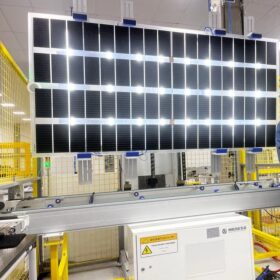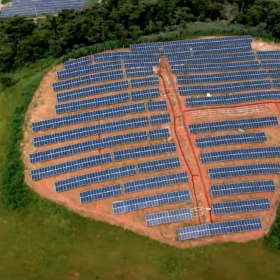Brazil’s PV capacity surpasses 38 GW
Brazil has pushed past 38 GW of total installed PV capacity, with around 26.3 GW consisting of distributed-generation solar systems.
Sao Paulo inaugurates 7 MW floating solar plant
The government of Sao Paulo, Brazil, says that a new 7 MW floating solar project on a reservoir in the megalopolis is the first phase of a 75 MW facility that will be completed in 2025.
Worldwide PV growth set to slow in 2024
The number of PV installations around the world grew by an annual average of 28% between 2019 and 2023, including a 56% jump from 2022 to 2023, according to Wood Mackenzie. Growth is not expected from 2024 to 2028, however.
Brazil set to install 9.3 GW of solar in 2024, says Absolar
New figures from Absolar, a Brazilian PV trade group, show that the country could install 9.3 GW of solar in 2024, bringing it to 45.5 GW of installed PV capacity by the end of next year.
Brazil’s solar capacity hits 34.9 GW, surpassing wind in national energy mix
Solar, at 34.9 GW of installed capacity, now accounts for 15.8% of Brazil’s energy mix, ranking second after hydroelectric plants at 49%, but ahead of wind power at 12.2%, according to the Brazilian Association of Photovoltaic Solar Energy (Absolar).
Comerc commissions 662 MW of solar in Brazil
Comerc has commissioned 662 MW of solar capacity in Várzea da Palma, Brazil. The facility will provide power to silicon metal producer Liasa via a long-term power purchase agreement (PPA).
BYD unveils new agrivoltaics module
Chinese module maker BYD is producing a new bifacial monocrystalline panel at its manufacturing facility in Sao Paulo, Brazil. The module has a power output of up to 355 W and a conversion efficiency of 16.33%.
Atlas Renewable Energy to sell solar plants to Engie Brasil Energia
Atlas Renewable Energy has expanded its ability to fund further plant development in Brazil by selling 545 MW of operating assets to Engie Brasil Energia for BRL 3.2 billion ($641 million). The acquisition will increase Engie’s share of Brazil’s utility-scale solar generation capacity from 3% to 9%.
Distributed-generation solar hits 24 GW in Brazil
Brazil has reached a milestone in its distributed-generation solar capacity, with a total of 24 GW. Since April, it has deployed an additional 4 GW of distributed solar capacity. However, the third quarter of this year marked the first signs of a market contraction.
EnerVenue sells 525 MWh of nickel-hydrogen batteries to VedantaESS
Brazil-based VedantaESS has agreed to buy EnerVenue’s energy storage vessels for use in utility-scale, distributed-generation and isolated microgrid applications.









